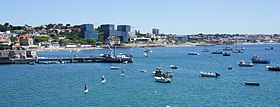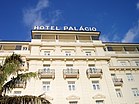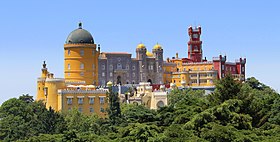Portuguese Riviera
Riviera Portuguesa | |
|---|---|
|
Clockwise: View of coast from Cascais Citadel; Hotel Palácio in Estoril; Casa de Santa Maria in Cascais; Pena National Palace in Sintra; Cascais Marina; Monserrate Palace in Sintra. | |
| Country | Portugal |
| District | Lisbon District |
| Municipalities | |
The Portuguese Riviera (Portuguese: Riviera Portuguesa) is a term used in the tourist industry for the affluent coastal region to the west of Lisbon, Portugal, centered on the coastal municipalities of Cascais (including Estoril), Oeiras and Sintra.[1][2][3] It is coterminous with the Estoril Coast (Costa do Estoril)[4] and occasionally known as the Costa do Sol (Sun Coast). Portuguese themselves do not use this expression.
The region is internationally known as a luxury destination for its history as a home of the wealthy, the famous, and European royalty.[5][6][7] Cascais, Oeiras and Sintra municipalities consistently rank among the richest municipalities in Portugal.[8][9][10][11]
Cascais's history as a center originates in the 1870s, when King Luís I of Portugal and the Portuguese royal family made the seaside town his summer residence, thus attracting members of Portugal's aristocracy, who established a summer community there.[citation needed] During World War II and the Post-War period, the area's royal affiliations intensified, as many heads of European royal houses and deposed monarchs, including King Edward VIII of the United Kingdom, King Juan Carlos I of Spain, and King Umberto II of Italy made their home in Cascais and Estoril, finding refuge in Portugal's neutrality in the war or from tense political situations in their own countries.[12] Due to its concentration of high-profile personalities, the riviera became a center of espionage during WWII, inspiring author Ian Fleming in his creation of the James Bond series.[13][14][15]
Sintra had been a royal retreat since the Portuguese Renaissance in the 15th century, but it was in the 19th century, when King Fernando II of Portugal decided to build his summer retreat, Pena Palace, in the Sintra Mountains overlooking the Atlantic Ocean, that it became both the center of the Romanticist movement in Portugal and the summer residence of the Portuguese nobility. Famous for its grand estates and palaces, Sintra's belle epoch resulted in its numerous villas, gardens, estates, and palaces that characterize the area, which gained Sintra a UNESCO World Heritage designation.[16] Today Sintra is one of Portugal's most expensive and exclusive real estate markets and similarly known for its high standards of living, consistently ranking as one of the best places to live in Portugal.[17][18][19][20][21][22][23]
- ^ Karen Brown; Clare Brown; June Eveleigh Brown; Cynthia Sauvage (2006). Karen Brown's Portugal, 2007: Exceptional Places to Stay & Itineraries. Karen Brown's Guides. pp. 54–56. ISBN 978-1-933810-15-7.
- ^ Marina Times - The Portuguese Riviera
- ^ Scots Travel - Exploring the Portuguese Riviera: Casais & Sintra
- ^ Abigail Hole; Charlotte Beech (2005). Lonely Planet Portugal. Lonely Planet. p. 131. ISBN 978-1-74059-682-4.
- ^ Melanie K. Smith; Greg Richards (2013). The Routledge Handbook of Cultural Tourism. Routledge. pp. 92–93. ISBN 978-0-415-52351-6.
- ^ Hello Magazine - The Portuguese Riviera
- ^ Maxima - Onde andam as celebridades que moram ou visitam Portugal?
- ^ "Jornal Economico - Lisboa, Cascais e Sintra são os municípios que mais encaixam com IMI". Archived from the original on 2019-03-27. Retrieved 2018-08-10.
- ^ RTP - Seis dos quinze concelhos mais ricos situam-se na Região de Lisboa
- ^ Publico - Grande Lisboa e a Regiao Iberica Mais Rica em Poder de Compra
- ^ Correio 24Horas - Sintra fica do lado de Lisboa e tem a maior cara de conto de fadas
- ^ Hello - Holiday like a Royal in Cascais: A Gem on the Portuguese Riviera
- ^ Saveur - Estoril: The Seaside Portuguese Town that Inspired James Bond
- ^ RCL Exclusive - Inside the Palácio Estoril, the Enchanting Hotel That Inspired James Bond
- ^ Publico - James Bond Teve uma Vida Real e Andou pelo Estoril onde Nasceu
- ^ Boots n All - Lisbon Coast: Portuguese Riviera
- ^ Cascais e a Terceira Melhor Cidade do Pais, depois de Lisboa e Porto
- ^ Eurodicas - Melhores Cidades de Portugal
- ^ Folha de S. Paulo - Mercado imobiliário em alta dá apelido de nova Miami a Lisboa
- ^ Diario de Noticias - Sintra reduz taxas para empreendimentos de luxo
- ^ Sapo Economia - Investir 1,3 milhões de euros para vender imóveis de luxo em Lisboa
- ^ Diario de Noticias - Portugal é a nova Miami para os brasileiros ricos
- ^ Expresso - O negócio milionário das casas de luxo em Portugal





